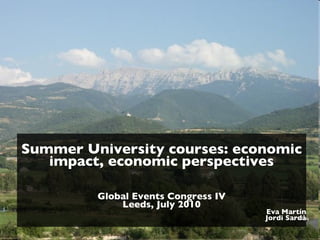Summer University courses: economic impact, economic perspectives
- 1. Summer University courses: economic impact, economic perspectives Global Events Congress IV Leeds, July 2010 Eva MartĂn Jordi SardĂ
- 2. Outline Introduction Business tourism and economic cycle Events organized by UdL Methodology Economic impact Conclusions
- 3. Economic impact by event organization Extensive literature on impact achieved by event organization Literature on economic impact generated by ordinary activity at universities No studies focussing on the big significance of events organized by universities
- 4. Year 2008 18,790 meetings 770.942 attendants in 1995 3.356.432 attendants in 2008 — Spain Convention Bureau Event and economic cycle
- 5. Direct economic impact 4,560 billion euro 0.42% Spain’s GDP — Spain Convention Bureau Event and economic cycle
- 6. Number of meetings and participants and GDP real (1999 = 100) Event and economic cycle
- 7. Number of meetings and participants and GDP real. Variation rates. Event and economic cycle
- 8. Attendance at events is independent of the economic cycle Tourism business events a priori is not affected by crises Event and economic cycle
- 9. Number of meetings Quarterly distribution
- 10. Main period Autum and Spring Key role in helping to the deseasonalisation of tourism
- 11. The average expenditure of a business tourist is 3.2 times higher than a traditional tourist — IET Event and economic cycle
- 12. Number of meetings Sectoral distribution
- 13. University of Lleida (UdL) Medium-small size university About 8,000 students in seven faculties Located in northeastern Spain
- 14. Lleida
- 15. University of Lleida (UdL) Founded year 1300 Created on 12th Desember 1991 7 faculties in 4 campus More than 50 grades and master
- 16. Since 1993 Opened to university students and to the society Far from the headquarters of the University During 2009, 39 courses 16 courses held in la Seu d’Urgell during 2 weeks 385 attendats and 63 teachers Summer University
- 17. 33% students of the own University 7% from other spanish universities 60% from professional field 71% province of Lleida 12% Catalonia Other points of Spain and Europe Summer University
- 18. Research process Teachers and students answered a questionnaire on the distribution and amount of their expenses during their stay in the summer courses
- 19. Sample 385 students, 344 (the 89.35%) answered the survey 108 came from the area, were not taken into account as generators of economic impact
- 20. Sample 63 teachers, 38 (the 60.3%) answered the survey About 32% of these teaching staff brought their families and their expenses were also included
- 21. Expenditure distribution 114,018.82 € 68,720.72 € 45,298.10 € Total 2,598.14 € 1,660.94 € 937.20 € Entrepreneurial Services 2,815.20 € 0.00 € 2,815.20 € Transports 95,087.19 € 57,091.49 € 37,995.70 € Hospitality 13,518.29 € 9,968.29 € 3,550.00 € Commerce Total Students Organization and Professors Â
- 22. Input Output Methodology Measure the capacity of generating benefits by the organization of an event Economic Impact
- 23. Input Output Methodology X = (I – A) -1 * Y Total = Total * Final Output Requirements Demand X is the production vector of the economy, I is the identity matrix, A is the matrix of technical coefficients, Y is the total final demand vector of the economy and (I – A) -1 is the Leontief inverse matrix ΔX = (I – A) -1 * ΔY
- 24. Sectors receiving investment Investment Direct Effect Inputs Demand Target sectors Of inputs demand Indirect Effect Total Effect Employment Consumption Sectors production Induced effect
- 25. Economic Impact Sectoral distribution
- 26. Economic Impact 2.67 304,155.7 Total Effect 1.23 140,056.4 Induced Effect 0.44 50,080.5 Indirect Effect 1.00 114,018.8 Direct Effect Multiplier effects Production Â
- 27. Conclusions Revitalization the tourism with visitors for academic and professional purposes They generate revenues in the city with its consumption
- 28. Global impact in production is 2.67 times larger than the initial demand generated by UdL summer courses 3.4% of GDP at 2006 prices of the city during these fifteen days Conclusions
- 29. Conclusions S ocial benefits: promotion of the city through the media that covers the visit of personalities or bringing studies to a city where there is no university. Positive economic impact because it helps to increase tourism revenues .
- 30. Conclusions Universities can use summer courses to advertise themselves through the news in the press Summer courses can be used as test laboratories when planning new future actions
- 31. Conclusions Finally, this paper may serve as a decision tool for city councils in order to try to host summer courses in their city organized by any University
- 32. Summer University courses: economic impact, economic perspectives Global Events Congress IV Leeds, July 2010 Eva MartĂn Thank you very much Jordi SardĂ
































